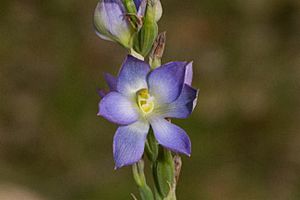Giant sun orchid facts for kids
Quick facts for kids Giant sun orchid |
|
|---|---|
 |
|
| Thelymitra grandiflora in the Scott Creek Conservation Park | |
| Scientific classification | |
| Genus: |
Thelymitra
|
| Species: |
grandiflora
|
The Thelymitra grandiflora, often called the giant sun orchid, is a special type of orchid. It grows only in South Australia, meaning it is endemic to that area. This beautiful plant has a single, tall, long leaf and can grow up to forty large, shiny blue or greenish-blue flowers with darker lines.
What Does the Giant Sun Orchid Look Like?
The giant sun orchid is a perennial herb, which means it's a plant that lives for more than two years and doesn't have a woody stem. It grows from a tuber, which is like a small underground storage part.
Each plant has one tall, thick, dark green leaf that is shaped like a spear. This leaf can be about 25 to 40 centimetres (10 to 16 inches) long and 2.5 to 3.5 centimetres (1 to 1.4 inches) wide.
The orchid's flowers are truly eye-catching! Up to forty flowers grow on a tall stem that can reach between 30 and 100 centimetres (12 to 39 inches) in height. Each flower is about 3 to 4 centimetres (1.2 to 1.6 inches) wide and has a shiny, metallic blue or greenish-blue colour with darker lines.
The flower parts, called sepals and petals, are about 1.5 to 2 centimetres (0.6 to 0.8 inches) long. The central part of the flower, called the column, is white or cream-coloured. It's about 6 to 7 millimetres (0.24 to 0.28 inches) long.
The top part of the anther (where pollen is made) is pale brown with a yellow tip. It's curved and has small, uneven teeth. The side parts of the column have fluffy, white hairs that look like mops!
These orchids rely on insects to help them pollinate, which means insects carry pollen from one flower to another. The flowers usually open up on warm days. You can see them blooming from September to December.
How Did the Giant Sun Orchid Get Its Name?
The Thelymitra grandiflora was first officially described in 1882 by a person named Robert D. FitzGerald. He wrote about it in a publication called The Gardeners' Chronicle.
The second part of its scientific name, grandiflora, comes from two Latin words:
- grandis, which means "large"
- flos, which means "flower"
So, grandiflora basically means "large-flowered," which makes sense because these orchids have big, beautiful blooms!
In 2014, another scientist named Robert John Bates described two slightly different types of this orchid, which are called subspecies. These names are now officially recognized:
- Thelymitra grandiflora subsp. grandiflora
- Thelymitra grandiflora subsp. exposa
Where Does the Giant Sun Orchid Live?
The giant sun orchid likes to grow in forests and areas with lots of bushes, often in rocky places. It is quite common in the Mount Lofty Ranges and Southern Flinders Ranges in South Australia.
It has also been seen on the Yorke Peninsula and Kangaroo Island in the past. However, sadly, it might not be found in those areas anymore.

